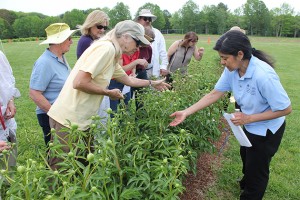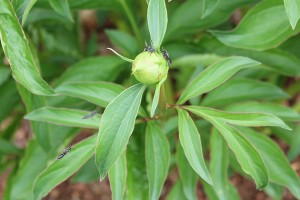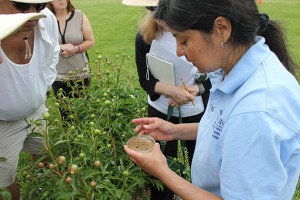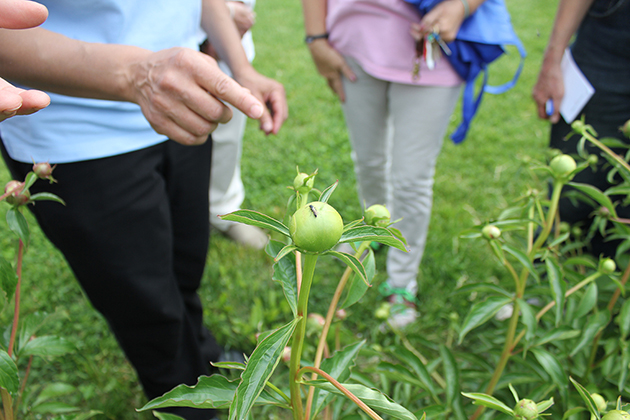
On an overcast morning in May, 15 people sit on bales of hay in a semi-circle while listening to Ana Legrand, an assistant extension professor in the Department of Plant Science and Landscape Architecture. The workshop attendees are here to learn about UConn’s efforts to reduce the population of Japanese beetle larvae (white grubs) without chemical intervention.
Connecticut homeowners and groundskeepers battle the Japanese beetles pests each summer, partly because of the damage done by the grubs’ feeding on roots of plants like turfgrass. Legrand is investigating the usefulness of a parasitic wasp, called Tiphia vernalis or spring Tiphia, as a biological control for these beetle grubs.
Behind Legrand are her three peony research plots, part of the 153-acre Plant Science Research and Education Facility, about a mile from the edge of UConn’s Storrs campus. The facility has almost 39 acres under active cultivation with a variety of crops.

Peonies are important to the wasps’ nutrition, as the nectar from the buds is an ideal sugary food source. The female Tiphia needs nourishment and a husky body for the task of digging to lay its eggs. After mating, she digs into the soil, searches for a grub host, paralyzes it and attaches an egg. Wasps lay about 50 eggs, one egg in each grub. After the wasp larvae hatch, they feed on and kill their hosts, thus preventing further Japanese beetle damage to roots and plants.
Legrand’s study of Tiphia is included in the objectives of a multi-state, five-year grant to investigate the biological control of arthropod pests and weeds. So far, Tiphia wasps show promise in lowering the numbers of Japanese beetles. In one location, Legrand found that 61 percent of the grubs sampled in mid-June had been parasitized by a wasp.

For those who want to provide nectar in their own home gardens and help the wasp do its job of preying on the grubs, Legrand recommends peonies. In her research, she has found that they are the most attractive of the ornamental plants tested, and are not susceptible to Japanese beetle feeding. The variety of peony also matters: ‘Festiva Maxima’ and ‘Bowl of Beauty’ are less susceptible to disease than other cultivars tested and are planted in the UConn research plots.
Legrand cautions that planting peonies to feed Tiphia is not the answer to all Japanese beetle pest problems, but says she sees it as one part of the solution.
To learn more about similar outreach activities, go to the Department of Plant Science and Landscape Architecture and UConn Extension websites. More information about biocontrol is available at the Integrated Pest Management website and Tiphia Fact Sheet.
This article was first published in Naturally@UConn, the newsletter of the College of Agriculture, Health, and Natural Resources.



